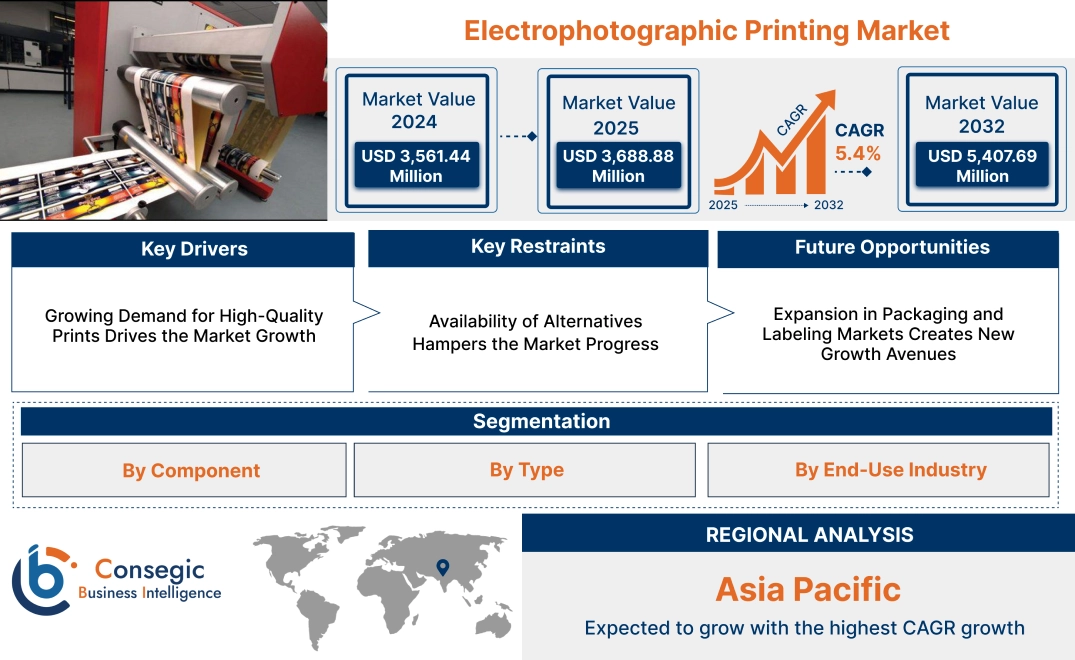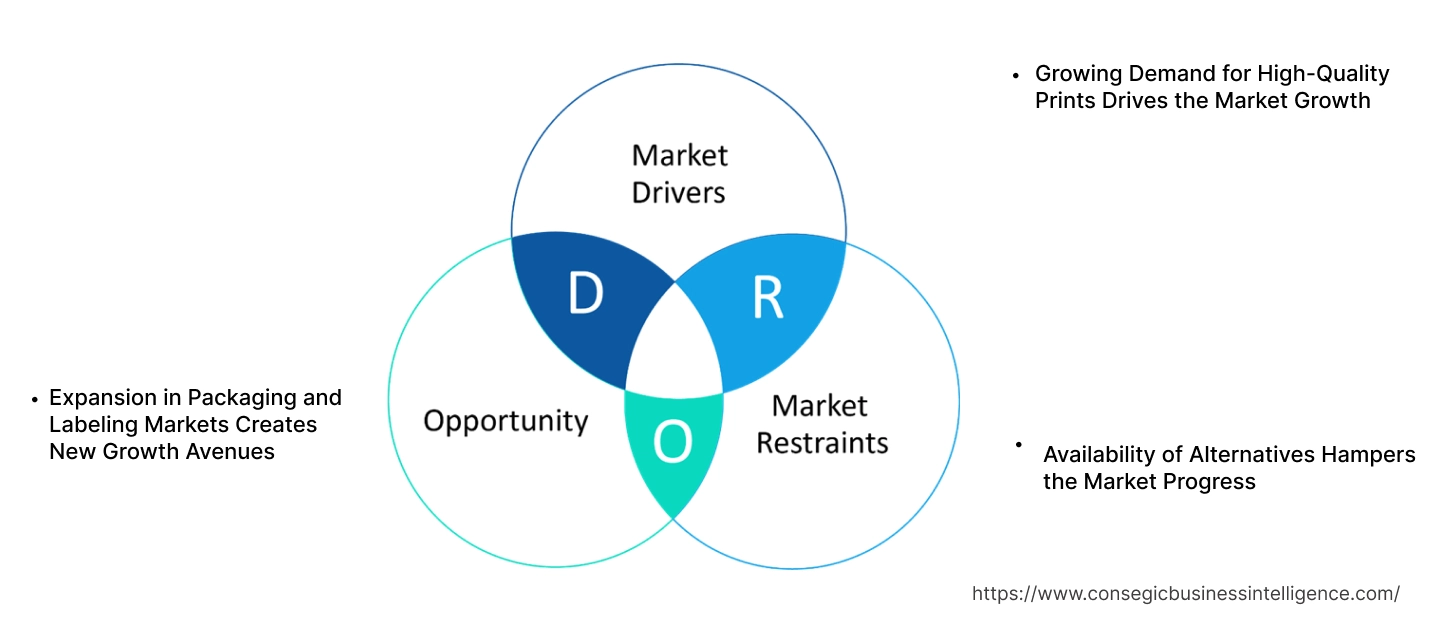- Summary
- Table Of Content
- Methodology
Electrophotographic Printing Market Size:
Electrophotographic Printing Market size is estimated to reach over USD 5,407.69 Million by 2032 from a value of USD 3,561.44 Million in 2024 and is projected to grow by USD 3,688.88 Million in 2025, growing at a CAGR of 5.4% from 2025 to 2032.
Electrophotographic Printing Market Scope & Overview:
Electrophotographic printing, commonly known as laser printing or xerography, is a digital printing technology that uses electrostatic charges to transfer toner or liquid ink onto a substrate, producing high-quality prints. This method is widely used for applications such as commercial printing, packaging, publishing, and office printing due to its precision, speed, and versatility.
The process involves creating an image on a photoreceptor drum using laser or LED technology, which attracts toner particles to the charged areas. The toner is then transferred to the printing medium, such as paper, and fused using heat or pressure to produce the final output. These printing systems are designed for high-resolution printing, offering consistent and sharp results across various print volumes.
End-users include commercial printing businesses, corporate offices, and packaging companies requiring reliable and efficient printing solutions for diverse needs. Electrophotographic printing plays a crucial role in delivering high-quality outputs for both high-volume and on-demand printing applications.
Key Drivers:
Growing Demand for High-Quality Prints Drives the Market Growth
The growth in need for high-quality, detailed prints across industries like packaging, commercial printing, and advertising is a major factor driving market growth. In sectors where image quality is crucial, such as in branding and marketing materials, printing technology that ensures sharp, precise details and vibrant color accuracy is essential. With advancements in printing technology, businesses produce superior prints that meet the evolving standards of consumer expectations for high-definition images and high-quality outputs. This trend is particularly noticeable in industries like packaging, where the presentation of products is crucial to attract customers, and in commercial printing, where requirement for detailed brochures, catalogs, and promotional materials continues to rise. As businesses seek to provide a premium experience for consumers, the need for advanced printing solutions that deliver exceptional image quality remains a strong driver for electrophotographic printing market growth.
Key Restraints:
Availability of Alternatives Hampers the Market Progress
One restraint in the market is the availability of alternative printing technologies that offer competitive advantages in specific applications. Other printing methods, such as flexographic printing or digital printing, are often more suitable for high-volume production or specialized materials. For example, flexographic printing is commonly used in packaging due to its high-speed capabilities and cost-effectiveness for large runs. Additionally, digital printing technologies offer faster setup times and more customization options compared to traditional methods, providing a compelling alternative for short-run jobs or personalized products. The existence of these alternatives with different strengths in terms of cost, speed, and material compatibility limits the adoption of other printing technologies in markets that prioritize efficiency, flexibility, and cost reduction. As businesses weigh their options for production methods, the availability of these alternatives hinder the electrophotographic printing market demand.
Future Opportunities :
Expansion in Packaging and Labeling Markets Creates New Growth Avenues
The growing demand for customized and high-quality packaging, especially in industries like food and beverage, pharmaceuticals, and consumer goods, presents a significant opportunity for the market. As businesses increasingly focus on branding and product differentiation, there is a need for printing solutions that deliver sharp, vibrant images and precise text. The ability to print on a variety of substrates, including paper, plastic, and metallic materials, makes this technology highly versatile for packaging and labeling applications. These systems also enable the creation of intricate designs, barcodes, and QR codes, which are crucial for consumer engagement and product traceability. As consumers need more personalized and visually appealing packaging, and regulatory requirements for labeling become stricter, the need for high-quality, flexible printing solutions continues to rise, driving the electrophotographic printing market opportunities.
Electrophotographic Printing Market Segmental Analysis :
By Component:
Based on component, the market is segmented into toners, drums, fusers, transfer belts, and others.
The toners segment accounted for the largest revenue of the total electrophotographic printing market share in 2024.
- Toners are a critical component of electrophotographic printing, enabling the transfer of high-quality images and text onto various media types.
- The increasing adoption of color printing has significantly boosted the demand for advanced toners, including polymerized and chemically produced toners, which offer superior print quality and durability.
- Toners are widely used across industries such as advertising and packaging, where vibrant and detailed prints are essential for enhancing brand communication.
- Thus, as per the market trends, innovations in toner formulations, such as eco-friendly and low-melt toners, cater to the rising requirement for sustainable and energy-efficient printing solutions, fueling the electrophotographic printing market expansion.
The drums segment is expected to grow steadily during the forecast period.
- Drums, also known as photoreceptor drums, are integral to the electrophotographic process, ensuring precise image transfer from the laser beam to the paper.
- The growth in need for high-volume and high-resolution printing in industries like publishing and education drives the adoption of durable and long-lasting drums.
- Advances in drum materials, including organic photoconductors (OPCs), enhance the efficiency and lifespan of printing systems, reducing operational costs for end-users.
- As per the electrophotographic printing market trends, the segment benefits from the rising use of multifunction printers that need robust and reliable drum components.
By Type:
Based on type, the market is segmented into monochrome printing and color printing.
The color printing segment accounted for the largest revenue of the total electrophotographic printing market share in 2024.
- Color electrophotographic printing is widely adopted in advertising, packaging, and retail industries due to its ability to produce high-quality, vibrant prints that attract consumer attention.
- The segment benefits from advancements in color printing technology, including high-resolution capabilities and extended color gamuts, enabling accurate and detailed reproductions.
- Increasing investments in marketing and branding initiatives have driven the need for color printing in applications such as brochures, labels, and product packaging.
- As per electrophotographic printing market analysis, the integration of color printing with digital workflows and variable data printing solutions further enhances its adoption across multiple industries.
The monochrome printing segment is anticipated to witness steady adoption during the forecast period.
- Monochrome electrophotographic printing is widely used in cost-sensitive applications such as office documentation, educational materials, and transactional printing.
- The segment is driven by the affordability and efficiency of monochrome printing systems, making them ideal for high-volume production environments.
- Technological advancements in monochrome printers, including faster print speeds and improved resolution, support their sustained relevance in various industries.
- Therefore, monochrome printing remains a preferred choice in industries where precision and readability are prioritized over color output, driving the electrophotographic printing market growth.
By End Use Industry:
Based on end-use industry, the market is segmented into advertising, packaging, manufacturing, education, and others.
The advertising segment accounted for the largest revenue of 36.5% share in 2024.
- Electrophotographic printing is extensively used in advertising to produce high-quality banners, posters, and brochures that effectively convey brand messages.
- The segment benefits from the growing requirement for personalized marketing materials, which leverage variable data printing to create targeted advertising campaigns.
- Industries such as retail and hospitality rely on this printing for creating visually appealing promotional materials that enhance customer engagement.
- As per electrophotographic printing market trends, the rising use of digital printing in outdoor and indoor advertising applications reinforces the dominance of this segment.
The packaging segment is projected to grow at the fastest CAGR during the forecast period.
- Electrophotographic printing is increasingly used in packaging for creating detailed labels, cartons, and flexible packaging with vibrant colors and high precision.
- The rise of e-commerce has driven need for customized and branded packaging, boosting the adoption of this printing in this sector.
- Innovations in printing technology, including quick turnaround times and the ability to handle diverse substrates, makes this printing ideal for short-run packaging applications.
- As per electrophotographic printing market analysis, the integration of digital printing solutions with packaging workflows supports the segment’s rapid expansion.
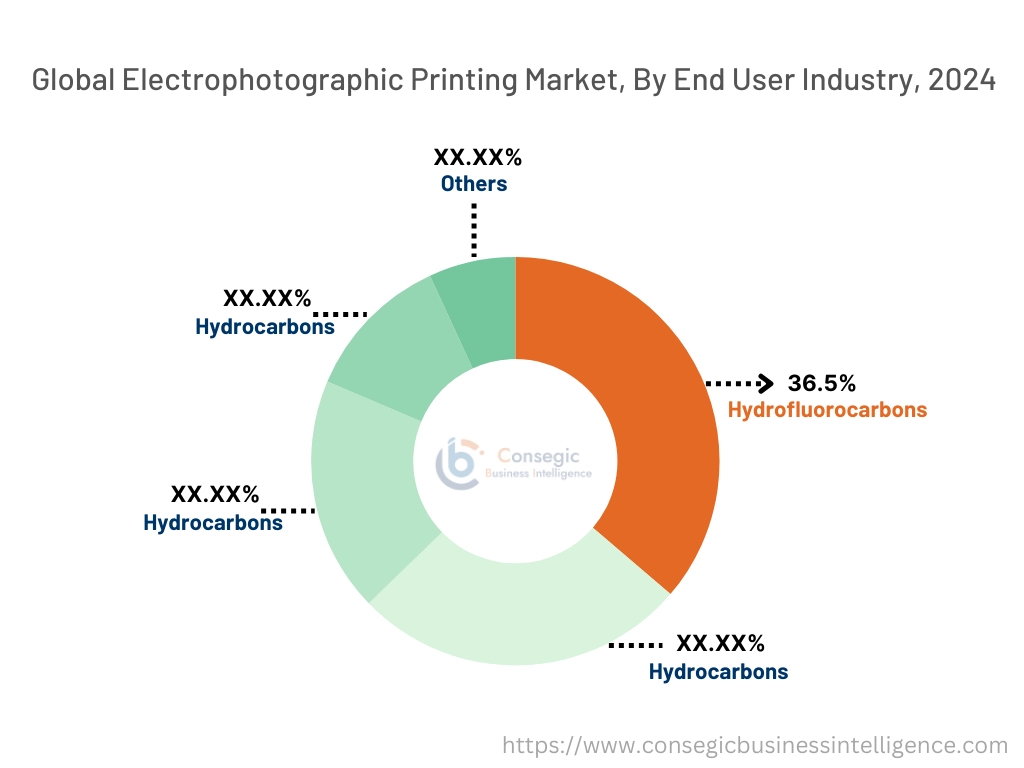
Regional Analysis:
The regions covered are North America, Europe, Asia Pacific, the Middle East and Africa, and Latin America.
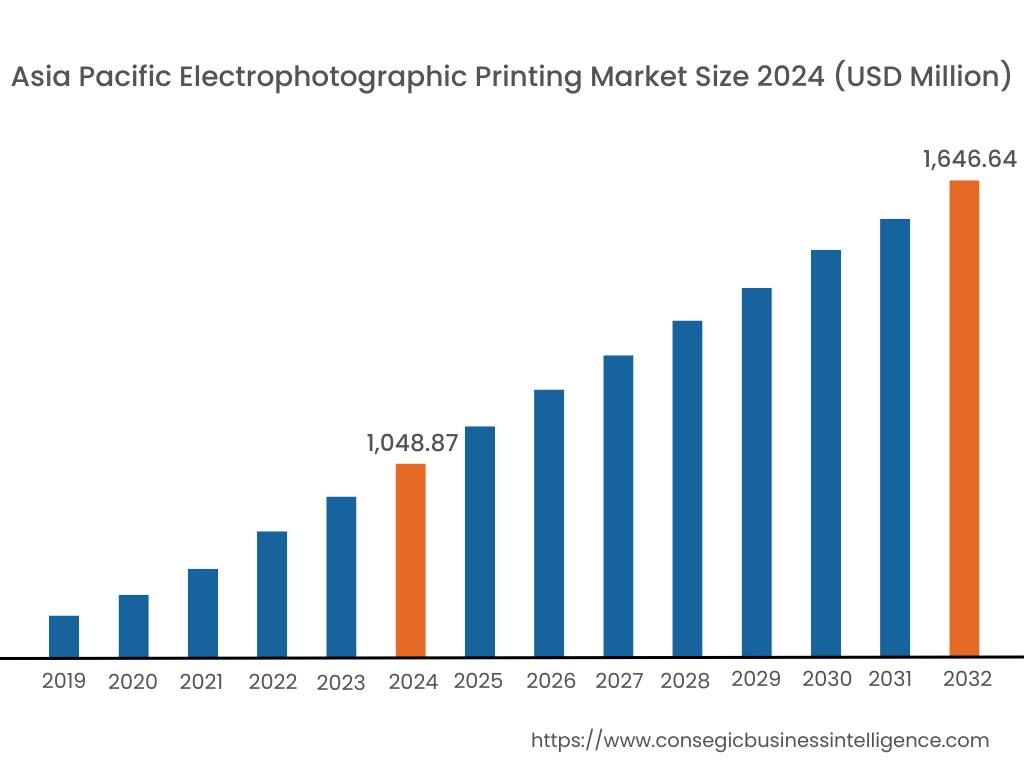
Asia Pacific region was valued at USD 1,048.87 Million in 2024. Moreover, it is projected to grow by USD 1,089.48 Million in 2025 and reach over USD 1,646.64 Million by 2032. Out of this, China accounted for the maximum revenue share of 31.4%. The Asia-Pacific region is witnessing rapid advancements in the electrophotographic printing market, attributed to technological innovations and increasing disposable income levels. A prominent trend is the rising sales of printers and computers, leading to higher adoption of printing in both commercial and residential settings. Analysis indicates that countries like Japan are expected to hold significant market share due to developing manufacturing companies and high requirement for digital printing.
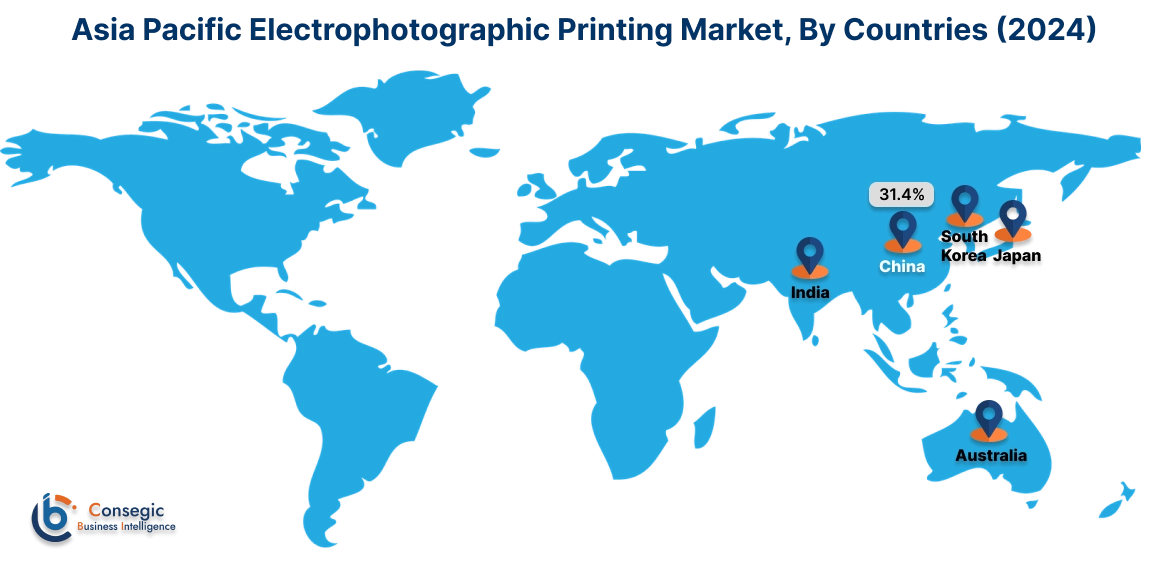
North America is estimated to reach over USD 1,752.63 Million by 2032 from a value of USD 1,181.36 Million in 2024 and is projected to grow by USD 1,221.29 Million in 2025. This region maintains a prominent position in the electrophotographic printing sector, driven by a well-established printing industry and substantial investments in marketing and advertising. A notable trend is the increasing utilization of this type of printing for high-volume tasks, including catalogs, magazines, and promotional materials. Analysis indicates that the demand for precision and efficiency in printing processes is a key factor influencing electrophotographic printing market opportunities in North America.
European countries are pivotal in the electrophotographic printing market, with a strong emphasis on sustainability and technological innovation. A significant trend is the adoption of eco-friendly printing practices and materials, aligning with the region's environmental regulations. Analysis suggests that the packaging industry in Europe is increasingly incorporating this system of printing for product labels and packaging solutions, enhancing visual appeal and brand differentiation, further boosting the electrophotographic printing market demand.
In the Middle East and Africa, the electrophotographic printing market is influenced by the adoption of advanced printing technologies to support infrastructure development and industrial diversification. The focus is on utilizing this printing in advertising and security applications, catering to the region's evolving business landscape. Analysis suggests that collaborations with international technology providers are facilitating the transfer of knowledge and expertise, aiding in the establishment of local printing capabilities.
Latin American countries are increasingly recognizing the importance of electrophotographic printing in enhancing the quality and efficiency of printing services. A notable trend is the modernization of printing infrastructure to meet the growing need for high-quality printed materials in sectors such as advertising and packaging. Analysis indicates that economic development and the pursuit of technological advancement are key factors influencing the electrophotographic printing market expansion in this region.
Top Key Players and Market Share Insights:
The Electrophotographic Printing market is highly competitive with major players providing products and services to the national and international markets. Key players are adopting several strategies in research and development (R&D), product innovation, and end-user launches to hold a strong position in the global Electrophotographic Printing market. Key players in the Electrophotographic Printing industry include -
- HP Inc. (USA)
- A B Graphic International Ltd. (UK)
- Eastman Kodak Company (USA)
- Fuji Xerox Co., Ltd. (Japan)
- Canon Inc. (Japan)
- Landa (Israel)
- Xeikon (Belgium)
- Anglia Labels (Sales) Ltd. (UK)
- Cenveo Corporation (USA)
- Associated Labels Inc. (Canada)
Electrophotographic Printing Market Report Insights :
| Report Attributes | Report Details |
| Study Timeline | 2019-2032 |
| Market Size in 2032 | USD 5,407.69 Million |
| CAGR (2025-2032) | 5.4% |
| By Component |
|
| By Type |
|
| By End User Industry |
|
| By Region |
|
| Key Players |
|
| North America | U.S. Canada Mexico |
| Europe | U.K. Germany France Spain Italy Russia Benelux Rest of Europe |
| APAC | China South Korea Japan India Australia ASEAN Rest of Asia-Pacific |
| Middle East and Africa | GCC Turkey South Africa Rest of MEA |
| LATAM | Brazil Argentina Chile Rest of LATAM |
| Report Coverage |
|
Key Questions Answered in the Report
What is the size of the Electrophotographic Printing Market? +
The Electrophotographic Printing Market size is estimated to reach over USD 5,407.69 Million by 2032 from a value of USD 3,561.44 Million in 2024 and is projected to grow by USD 3,688.88 Million in 2025, growing at a CAGR of 5.4% from 2025 to 2032.
What are the key segments in the Electrophotographic Printing Market? +
The market is segmented by component (toners, drums, fusers, transfer belts, others), type (monochrome printing, color printing), and end-use industry (advertising, packaging, manufacturing, education, others).
Which segment is expected to grow the fastest in the Electrophotographic Printing Market? +
The packaging segment is projected to grow at the fastest CAGR during the forecast period, driven by the rise of e-commerce and the increasing demand for customized and branded packaging.
Who are the major players in the Electrophotographic Printing Market? +
Key players in the Electrophotographic Printing Market include HP Inc. (USA), A B Graphic International Ltd. (UK), Landa (Israel), Xeikon (Belgium), Anglia Labels (Sales) Ltd. (UK), Cenveo Corporation (USA), Associated Labels Inc. (Canada), Eastman Kodak Company (USA), Fuji Xerox Co., Ltd. (Japan), Canon Inc. (Japan).
